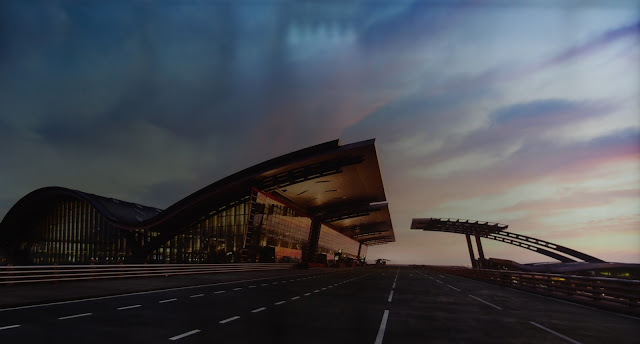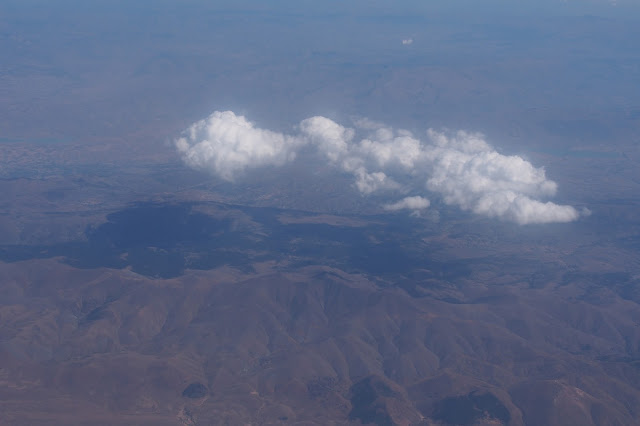The Balkans Peninsula has always remained little more than a name in my high school geography and the city of Sarajevo got just a brief mention when I learned about the events leading up to World War I. The rest remains a complete a blank. Before I found myself at Zagreb, Croatia, I had to make two stops, first in Dohar and then again at Budapest.
This is my first glimpse of the airport at Dohar, the capital of Qatar, also the name of my carrier.
A photo of the Qatar Airport which I took from another photo posted at the entrance of the corridor between two departure halls.
I arrived at the airport shortly before dawn which enabled me to see the rising desert sun shrouded in fine dust through the airport window .
Part of the VIP lounge
Another part of the VIP lounge there
Two shadows showing behind the glass
The Arabs really know how to make themselves look distinguished with their white head cloth with matching shirt and gown nicely fitted on their head with two black bands with a tassle trailing behind their back. I asked for permission to photograph this airport officer at the inquiry counter there. How smart he looks!
Clouds over Turkey
Clouds over Hungary
Approaching the airport at Hungary
The airport at Zagreb was fairly small. One can see the influence of artists like Mondrian at the transit hall.
The architecture was fairly basic: everything is exposed, all lines, rectangles and simple curves in black.
Some members of our tour group waiting at the airport for the arrival of our coach
Immediately after arriving in Zagreb, we were driven to a castle perched 130 metres atop of a limestone hill towering above Lake Bled in the neighboring country, Slovenia. It's the oldest castle in Slovenia, originally called Castellum Veldes and was first mentioned by the German King Henry II in a deed of donation when he gave the castle to the Bishop Albuin of Brixen in 1004.
At the entrance of the path leading up to the Castle gate, we found some red and white bow and ribbon, which seem to be the predominant colors of decoration there..
Flowers at the entrance to the castle. Apparently, some one was having a wedding feast up there. So the entrance was being decorated with ribbons.
There were flowers all along the pebble path leading up to the Castle
A close up of some of the flowers.
I like the combination of the red, green and white
The Castle used to be the residence of a Bishop given to him by a nobleman. Part of it is now turned into a restauran.
The staircase leading up to a small museum there on life around the region in the Middle Ages.
From the terrace outside the restaurant, one could see one of the oldest churches in the area.
Immediately below the castle is the famous Lake Bled with its canoes and other water sport and are littered with hotels and restaurants. A young couple is seen enjoying the summer sun on a float beside the pier
In the mist, one could see the opposite side of the lake
The Castle rises very steeply from the shores of his glacial lake
Another view of the steep cliff
One can see the lookout corridor above the roof
In the middle of a lake is another church built on the only natural island in Slovenia, the Bled Island
(Blejski otok) which is the site of the pilgrimage church dedicated to
the Assumption of Mary (Cerkev Marijinega vnebovzetja), built in its
current form near the end of the 17th century, and decorated with
remains of Mediaeval frescos and a rich Baroque style. There are 99 steps leading
up to the building and many love to have their wedding celebrated there and local tradition has it that if the
groom carries his bride up the 99 steps on the day of their wedding
before ringing the bell and then making a wish inside the church, that wish will come true! What would men not do just to win a lady of his heart?
.
.
The lake was covered by a veil of mist
This is the small chapel at the Castle
Red and white ribbon flying on the stands close to the parapet.
To celebrate the wedding, a bottle of champagne was slashed across its neck by an old fashioned a sword! You can see the sword and the upper part of the bottle neck on the try over the ledge of the parapet.
Dragon was the symbol of the country.
Part of the mural of the small chapel has become discolored.
Many of the original paintings have disappeared.
Behind the altar we find this sacristy in carved marble
St Peter in the Middle of the Sacristy
One of the local saints overcoming a monster
A hand made card in wood wafer sold at the souvenir shop at the museum next door, which houses some 400 original artefacts and replicas showing the geological, natural, general and art history of the region, with the Ice Age hunters, the first Stone Age tillers and stockbreeders, the Copper, Bronze and Iron Age settlers, inhabitants from the Roman Period and Late Antiquity, the Early Mediaeval and Early Slavic Period.
A storeroom at the basement of the museum
A life life-size family of 3 showing life in the Middle Ages
Survey and photographic instruments used by the former owner of the castle
A view of the surrounding country from one of the windows at the museum
Another view of the surrounding countryside, showing the sports field of a local school
One can see the mist rising in the evening amidst the distant hills
The skeleton of a girl of about 20 from nearby Pristava found close to the grounds of the Castle who lived at the 10th Century. When found, she was wearing the typical jewellery at the time, a pair of crescent-shaped earring, temple rings and a finger ring.
Some typical iron door lock and key used in the area between 17thC & 18thC
Flowers at an opening to the staircase leading from the ground floor to the museum
Entrance to the Museum
The windows are decorated in typical local fashion with red and white stips
The entrance to the Courtyard to the Chapel and Castle Museum
The emblem of the master of the castle
(to be cont'd)





















































沒有留言:
張貼留言